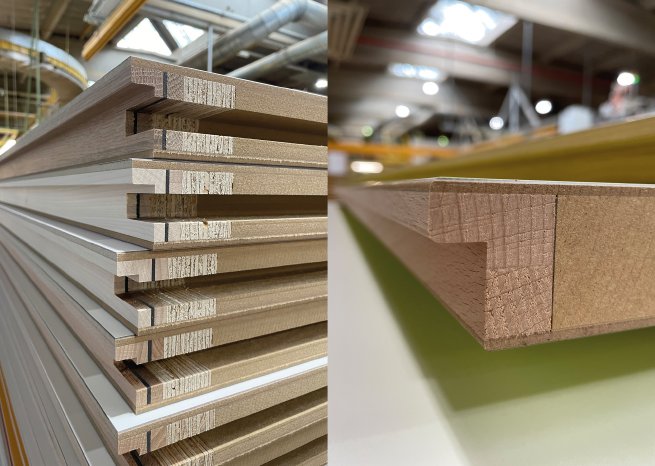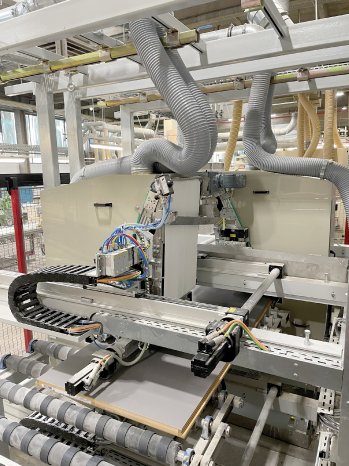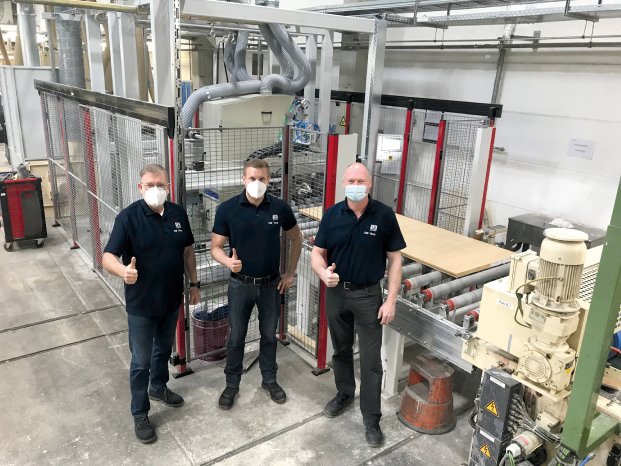JELD-WEN Door Solutions is part of the American JELD-WEN group, the largest supplier of doors and windows in the world. At its two German production sites in Mittweida and Oettingen and at its distribution site in Hamburg, the company uses state-of-the-art technology and around 900 highly motivated employees to produce a wide range of doors and door frames.
The edge spraying systems used in the Oettingen plant were ready to be replaced with a new more environmentally friendly and cost-saving option. Single or double rebates, child-safe or normal edges – producing functional doors with a seemingly endless variety of features frequently presents the door manufacturer with new challenges. Particularly when production is supposed to become more eco-friendly. In handcraft businesses, the door leaf surfaces are generally covered before spray-coating the edges, but in industrial spray coating it is simply accepted that some coating material will end up where it shouldn’t. “Until now any coating material spatters on the door leaves were washed off. To ensure that process is fast enough, highly active solvents are used and those later end up in the waste air in a highly diluted form,” Markus Uhl, Head of the Surface Department in Oettingen, explains the initial situation.
Looking for an environment-friendly solution
The first idea was to find a solution for filtering the solvents out of the exhaust air. But the solvent concentration in the exhaust air was too low to use an exhaust air cleaning system. “We would have had to use a gas-operated burner, generating hundreds of kilograms of additional carbon dioxide. This made use of a post-combustion unit utterly counterproductive,” plant manager Wolfgang Oswald explains. In the end, the company contacted the machine manufacturer Venjakob based in the German region of Eastern Westphalia. “We didn’t want to give up so soon, so we contacted surface finishing specialists we knew and trusted. Together with Venjakob, we turned an idea into a prototype and the prototype into a precise, automatic CNC-controlled edge spraying system. A protective jig system keeps the door leaves clean, so the post-spray cleaning process is no longer required. In conjunction with the new water-based edge coating material, this has led to a significant reduction in solvent use,” explains project manager Stefan Randi of JELD-WEN. The two edge spraying machines used previously have been replaced with the new system. The now obsolete washing units were dismantled.
Jig system with tolerance of a tenth of a millimeter
The edge coating system has a modular design and coats the different edges on both sides as they pass through the system. The longitudinal edges can be sharp-edged or, as with the childproof edge, equipped with a radius to the door face. The plant consists of a spray coating system, a jig system, and an extraction system. It has been integrated into the existing overall plant as an independent system. To permit coating of different edge profiles and door thicknesses, the doors are scanned as they enter the system, identified and the corresponding recipe is loaded fully automatically from the control system. The infeed of the edge spray booth is equipped with an additional workpiece detection system, which measures the door precisely and ensures that the spacing to the next door is correct. The dimensions are intended for fine adjustment – they permit height adjustment of the jig system and protect the units from damage caused by incorrectly supplied workpieces. “The jig system is adapted to the workpiece with high accuracy, as there are frequently minor deviations during door production, e.g. In the thickness or shape. We’re working with a jig system with a tolerance of only a tenth of a millimeter. That really is pretty accurate,” says Oliver Milde, customer account manager at Venjakob.
New water-based coating material tested first
The coating system by the paint manufacturer Hesse requested by the customer for coating the longitudinal door edges first underwent a series of tests at the Venjakob technical center and the result was approved by the customer. The water-based coating material is applied in two steps, with the application volume varying by wood type based on the program. After the first coating process, the workpieces are dried and then undergo intermediate sanding. This is followed by a second coating process and final drying.
Challenges when drafting the contract
The fact that the Oettingen-based door manufacturer is part of an American corporate group had effects on the drafting of the contract. It was necessary to draw up a contract that takes both American and European law into account. “This was a major challenge for all those involved. Such a contract is significantly more comprehensive, and our customers are grateful for our support in this matter,” says Oliver Milde. He adds that Venjakob has already adapted to future challenges regarding contract law and has obtained the necessary legal expertise. “When you consider that drafting of the contract took just as much time as the technical definition of this project, it is easy to imagine where the future will take us. We expect that there will be even more demand for this service soon,” underlines Oliver Milde.




